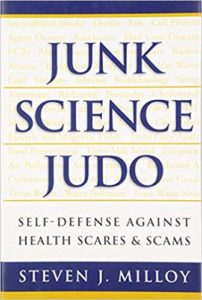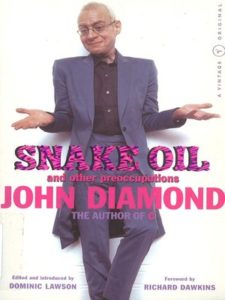Imaginary Hazards, Imaginary Cures
Review of
Junk Science Judo: Self-Defense Against Health Scares & Scams
Washington, D.C.: Cato Institute, 2001, 209pp
Snake Oil
London: Vintage, 2001, 285 pp.
Spectacular discoveries in the diagnosis, treatment, and prevention of disease have become the stuff of daily headlines. Diseases that have tormented humans for all of history have been virtually eradicated, life expectancy in the developed nations has doubled during the past century, and the quality of the added years continues to improve.
 Good news certainly, but many people seem ambivalent at best about this scientific revolution. Their respect for the achievements of medical science competes with nostalgia for a time when things seemed simpler and more natural. They feel threatened by new technologies that they don’t understand and long to hear that science has confirmed the remarkable benefits claimed for “natural” remedies.
Good news certainly, but many people seem ambivalent at best about this scientific revolution. Their respect for the achievements of medical science competes with nostalgia for a time when things seemed simpler and more natural. They feel threatened by new technologies that they don’t understand and long to hear that science has confirmed the remarkable benefits claimed for “natural” remedies.
In 1976, Paul Brodeur, a writer for The New Yorker, warned that microwave radiation in New York City from radio, television, and radar had risen to 100 million times the “natural” background level. Brodeur, who has no background in science, saw this as a shocking example of environmental degradation and a serious threat to public health. His numbers may have been accurate enough, but they meant only that natural background levels of microwave radiation are extremely small. That’s what makes microwave communication so useful: Microwaves fall in a “quiet” region of the electromagnetic spectrum, where there is little interference from natural sources.
Brodeur was convinced that the levels of microwaves to which we are exposed in modern society are the cause of serious health problems, including cataracts and cancer. Whether microwave backgrounds exceed natural levels, however, is simply irrelevant. Most studies found scant evidence of health effects, and in spite of Brodeur’s warnings, people began to discover the convenience of microwave ovens. For most people, fear of microwaves leaking from their appliances gradually subsided.
With the advent of the cell phone in the 1990s, however, a new generation of fearmongers appeared, insisting that microwave radiation from handheld cell phones was inducing brain cancer. The whole process of reassuring the public had to be repeated. Once again, more careful studies failed to confirm the early reports, and the convenience of this new technology seems to be gradually pushing aside any lingering concerns.
Do cell phones cause cancer? Is the evidence linking secondhand smoke to heart disease credible? Does dioxin actually interfere with tooth development in children? Do women who have had abortions run a higher risk of developing breast cancer? Do gunlock laws really protect children from firearm accidents? In Junk Science Judo, Steven J. Milloy answers these and many other questions in the negative. Milloy, the publisher of JunkScience.com and an adjunct scholar at the Cato Institute in Washington, D.C., has written a sort of self-help manual for countering the flimsy and sometimes fraudulent evidence behind many of the health warnings trumpeted by the media. Such warnings often seem designed to rally support for the agenda of some group of dedicated activists, such as antismoking zealots or antiabortion fanatics. In his choice of targets, however, one begins to discern Milloy’s own libertarian agenda.
Milloy has good reason to be suspicious of health warnings backed by epidemiological studies that purport to find a statistically significant link between disease and some environmental factor, such as secondhand smoke. Epidemiology, after all, cannot establish cause and effect and is notoriously vulnerable to errors of inadequate statistical strength and confounding factors. A study of weight loss, for example, would find a very strong association with premature death–not because losing weight is bad for your health, but because chronic illness tends to waste away your body.
Milloy is on to all the tricks used by the fearmongers, but at times his approach seems better suited to coaching a basketball team than to building a scientific case. At the end of the first “lesson” (as he prefers to call the chapters), Milloy reassures his readers that eventually they will learn to spot the “junksters” and tune them out. “Until then,” he lectures them, “study hard and practice, practice, practice.” I could hear the voice of my high-school coach: “Just concentrate on your form and the ball will start dropping.”
Epidemiology is an important component of modern medical science, often providing the first indication of a serious problem. But because it is so easy to be misled, scientists have learned to insist that epidemiological evidence be supported by a plausible theoretical mechanism and backed up by solid laboratory evidence. For Milloy, however, statistics are pretty much the whole game. “Beat Statistics with Statistics” is the title of one of his 12 lessons.
Needed: A little science
We should never tolerate the sloppy use of statistics, but what we need may not be more statistics, but a little science. Epidemiological studies of cell phone use, for example, have repeatedly failed to demonstrate a link between cell phone use and brain cancer. Regardless of how convincing the statistical evidence may be, however, there will always be those who will insist that the issue is not yet settled. Cell phones are a relatively recent technology, and studies that find no link to cancer are dismissed by critics on the grounds that exposure must be studied over a longer period of time before we can be certain cell phones are safe. How much longer they don’t say. My guess is that it will never be long enough to satisfy the fearmongers.
All cancer agents act by breaking chemical bonds, producing mutant strands of DNA. Electromagnetic radiation is absorbed as photons, discrete packets of energy determined by the wavelength; the shorter the wavelength, the higher the energy. The near-ultraviolet component of sunlight, which consists of photons just energetic enough to break DNA, is responsible for the epidemic of skin cancer afflicting our sun-loving society. Electromagnetic radiation at still shorter wavelengths, x rays and gamma rays, also damages DNA, inducing cancer. But the visible portion of the spectrum cannot. No matter how great the exposure, there is simply not enough energy in photons of visible light, even at the violet end of the spectrum, to damage a strand of DNA.
This realization amounted to an enormous breakthrough in understanding cancer. We now know the cause of most skin cancers and can take steps to minimize exposure. We didn’t learn this from some statistical study of sunbathers. It resulted from an understanding of quantum mechanics and basic laboratory studies of the interaction of radiation with matter. Combined with our growing understanding of cancer development, the implications of this revelation go far beyond sun exposure. Microwave photons have much longer wavelengths than even visible light, longer even than the infrared radiation from warm objects, and are certainly not energetic enough to induce cancer. They don’t come even come close. Case closed.
Yet we attempt to counter the claims that cell phones induce cancer by doing still more epidemiology. This is viewed by the public as an admission that it’s an open scientific question and invites an endless quibble over statistical evidence that will never satisfy the fear industry.
 For every imaginary hazard, there must be a dozen claims of imaginary cures. When John Diamond, a popular columnist for the London Times, died after a seven-year fight with throat cancer, he left six chapters of a book he described as “an uncomplimentary book about complementary medicine.” Fortunately, his six chapters have been assembled and published as Snake Oil (Vintage, 2001), which would be worth the price just for the eloquent foreword written by biologist Richard Dawkins.
For every imaginary hazard, there must be a dozen claims of imaginary cures. When John Diamond, a popular columnist for the London Times, died after a seven-year fight with throat cancer, he left six chapters of a book he described as “an uncomplimentary book about complementary medicine.” Fortunately, his six chapters have been assembled and published as Snake Oil (Vintage, 2001), which would be worth the price just for the eloquent foreword written by biologist Richard Dawkins.
As a very public cancer victim, Diamond was targeted by proponents of alternative medicine, who assured him he was committing long-term suicide by relying on orthodox medicine. They said he should take Essiac, the treatment of choice among Native American tribes in Canada; try homeopathy; or visit clinics in Mexico just across the border from California for treatment with Laetrile, which is banned in the United States. They also sent him newsletters from organizations promoting the use of coffee enemas as a cancer cure. If there had been evidence that these treatments were effective, Diamond points out, they would no longer be alternative.
Diamond never had any illusions about his own prospects, but to the end he never lost his acerbic wit or his confidence in the simple logic of the scientific method. Take, for example, the following passage: “On every map of London, the only way you can get from the Tower of London to Bermondsey is by crossing the Thames. It’s the same with the body. However much you might want to believe otherwise, the blood will still carry oxygen from the lungs to the heart; the stomach will still refuse to distinguish between salicylic acid which comes from the bark of the willow tree and that which comes from Bayer’s aspirin factory; the immune system will still not respond to the non-existent amounts of active chemical in a homeopathic preparation.”
Junk Science Judo deals with imaginary health hazards; Snake Oil deals with imaginary cures. Read them both; they’re both good, but Diamond’s medicine tastes better.
